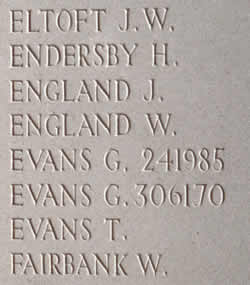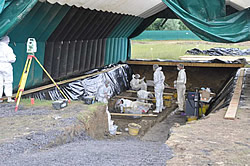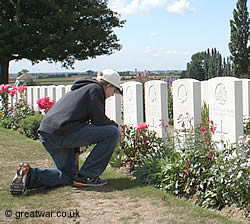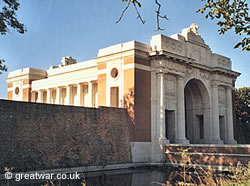War Graves for WW1 Dead on The Western Front
From the very first battles in the early weeks of the fighting on The Western Front the number of military dead was already in the tens of thousands. The French Army suffered particularly badly, with a figure of 80,000 dead out of 250,000 killed and wounded by the end of the First Battle of the Marne (5th to 12th September 1914).

|
As the war progressed over four years the casualties at each battle, whether it was a large-scale offensive or a more localised attack, were often very high. This was mostly as a result of the destructive capabilities of the weapons being used and the type of warfare being waged at that time.
This article describes the huge task of burying and identifying the war dead of 1914-1918, and the records of those casualties available to families and historians:
- Military Burials Before 1914
- Registration of the War Dead 1914-1918
- Finding the Missing WW1 Dead Almost 100 Years On
- International Treaties to Protect War Graves
- Records for the War Dead of WW1
- Cemeteries and Memorials on The Western Front
Military Burials Before 1914
Before the 19th century soldiers killed in combat were generally buried in communal graves which were not marked specifically as military burial sites. Only certain leaders or famous heroes were given the honour of a marked individual war grave.
In some of the 19th century battles, namely the Mexico-American War (1847-1850), the Crimean War at Sebastopol (1856) and Solferino (1859) and the Franco-Prussian War (1870-71), soldiers were buried in marked military burial sites. However, the remains of the individual soldiers in these sites were not separated into individual graves.
Registration of the War Dead 1914-1918

|
The scale of casualties in the First World War was unprecedented. Thousands of soldiers were being buried on the battlefields in individual or communal graves by their comrades. They were often buried where they fell in action, or in a burial ground on or near the battlefield. A simple cross or marker might be put up to mark the location and give brief details of the individuals who had died. In the early weeks of the war the British Army had no official register to whom these battlefield burials could be formally reported with a name and the location of the grave.
Those individuals who reached a hospital in a safe area behind the fighting lines and who died of their wounds would usually be buried in a cemetery near to the hospital. Often it would be in an existing town or village cemetery or in a specially created annexed burial plot. These burials could be registered and their locations marked.
The large numbers of dead also confronted the warring nations with the question of what the military authorities and official authorities should do about registering the burials of the dead. The families who had lost a loved one would naturally expect that a record of the soldier's grave would be kept for pilgrimage visits or for the body's repatriation.
As a result, official war graves registration services were established by many of the fighting nations during or after the First World War.
The “Missing”

|
The difficult task for the graves registration services was increased by the nature of the fighting on certain battlefronts, such as the Western Front. The characteristics of siege and trench warfare on this battlefront meant that fighting often moved back and forth over the same ground. Between battle actions the day to day survival in filthy holes or trenches dug in to the ground and the hazards of exploding artillery shells, snipers and grenades resulted in many casualties from sickness and wounds. Many casualties were lost in collapsed underground tunnelling operations to mine under enemy positions.
Conditions in the landscape often added to the number of casualties. Heavy, prolonged rain could turn the landscape into a sea of mud. Accounts by soldiers during the 1917 Battle of Passchendaele at Ypres tell of men drowning and disappearing in the waterlogged shell craters and deep, deep mud.
Graves and burial grounds situated in the area of a battlefront were often damaged by subsequent fighting across the same location, resulting in the loss of the original marked graves. Some bodies simply could not be retrieved from underground.
Added to this, the technical developments in the weaponry used by all sides frequently caused such dreadful injuries that it was not possible to identify or even find a complete body for burial.
These factors were generally responsible for the high number of “missing” casualties on all sides and for the many thousands of graves for which the identity is described as “Unknown”.
Commemorating the “Missing”

|
The nations involved in the First World War have chosen to commemorate the missing in various ways. There may be an official tomb or coffins in which an “Unknown” burial has been selected to represent the thousands of unidentified war dead of that country. There may be memorial walls in military burial grounds with names carved in stone or etched in bronze. Or there may be monuments with many thousands of names in battle sites to commemorate the individuals who are known to have died in that area but who have no known grave.
It is usually the victors who have the opportunity to put up memorials to honour their military dead. There may be many military dead, known or missing, from some nations who will never have their memory carved in stone or etched in bronze. Indeed, the German war graves agency, the Volksbund Deutsche Kriegsgräber Fürsorge (VDK) considers that there are still possibly approximately 80,000 German soldiers who fell in action in Flanders and whose remains cannot be accounted for. There is a similar figure for British casualties whose remains have never been found. They are all still “missing” in Flanders.
Finding the Missing WW1 Dead Almost 100 Years On

|
It may be surprising to learn that military “missing” dead from the First World War are still being found almost 100 years since the guns fell silent in 1918.
After the Great War the battlefields were carefully cleared of equipment, ammunition and debris. Known burial sites were examined and many burials in small cemeteries or individual graves were moved to larger concentration cemeteries. Some burial sites were left to a nation in perpetuity in gratitude for the sacrifice of these individuals.
However, some military dead have remained undiscovered for nearly 100 years since they fell. Some bodies have been disturbed by the construction of roads and houses. Some have been found by chance in the undergrowth in remote places.
The remains of Private George Nugent of the Northumberland Fusiliers were found in October 1998. He had been killed on 1st July, the first day of the Battle of the Somme 1916. He had been recorded as missing in action. His body was found close to the mine crater blown on that day, known as Lochnagar Crater. He was reburied in the nearby Ovillers Military Cemetery on 1st July 2000.
Rediscovered Burials of Allied Soldiers at Fromelles, France

|
In 2007 the remains of hundreds of British and Commonwealth military dead, believed to be mostly Australian soldiers, were discovered in mass grave burial pits near Bois Faisan (“Pheasant Wood”) near Fromelles in France. It was believed that they were buried there in 8 pits by the Germans after the Action at Fromelles (19th to 20th July 1916), when very heavy casualties were suffered by the British 61st Division and the Australian 5th Division. Although the area was searched after the First World War, and the location had been marked on trench maps from the 1914-1918 period, for whatever reason these burials were not discovered and officially marked.
On 31st July 2008 a statement was issued that all of the remains would be exhumed and reinterred in a new military cemetery. In April 2009 there was a formal announcement that DNA samples would be taken from the human remains to provide the best chance of any possible future identification of the bodies. The Commonwealth War Graves Commission took on the task of the exhumation and reinterment. The new military cemetery was constructed and the official dedication ceremony took place there in July 2010.
Fromelles (Pheasant Wood) Military Cemetery
International Treaties to Protect War Graves

|
From the middle of the 19th century a number of treaties were agreed to protect war graves in Europe. After the Second World War there were new problems for the war graves registration services to overcome. Many of the First World War cemeteries had still not been renovated before 1939 and following the Second World War there were more war dead to register, bury and care for.
The treaties were as follows:
- 1856: Treaty of Paris
- 10th May 1871: Treaty of Frankfurt. The French and German governments agreed in the treaty to allow the military dead of either nation to be taken back to their national soil for burial.
- 28th June 1919: Treaty of Versailles. Agreements by the signatories giving French land necessary for the purpose of maintaining a military cemetery.
- 26th November 1918, 31st October 1951: Franco-British Agreements
- August 1927, October 1947, October 1956: Franco-American Agreements
- 19th July 1966: Franco-German Agreement
- 2nd December 1970: Franco-Italian Agreement
Records for the War Dead of WW1

|
There are national agencies for each of the countries whose military casualties lie on the 1914-1918 battlefields of Belgium and France. These organizations care for the military graves and commemorative sites of 1914-1918, having been formally established during or after the First World War from the graves registration services of the warring nations' military forces. The war grave agencies maintain the records of where a serviceman or woman is buried or commemorated.
Also there are various other types of records which have been compiled either officially or unofficially which can help to establish additional details about an individual.
Rolls of Honour and Finding a Grave
For details about the various war grave agencies, memorials, rolls of honour and records available for researching those killed in WW1, and how to find a grave go to our page at:
Records for the War Dead of WW1
Cemeteries and Memorials on The Western Front
The lists of cemeteries and memorials commemorating the missing of the First World War on the Western Front for Allied and German forces are provided in sections on this website according to the battlefield region where they are located.
The location of each listed cemetery or memorial is provided and in some cases there is a page giving a variety of photographs, information and layout plan.
Cemeteries on the Western Front
Cemeteries on the Ypres Salient Battlefields
Cemeteries on the French Flanders & Artois Battlefields
Cemeteries on the Somme Battlefields
Memorials to the Missing on the Western Front

|
Memorials on the Ypres Salient Battlefields
Memorials on the French Flanders & Artois Battlefields
Memorials on the Somme Battlefields
Acknowledgements
(1) - (3) Photographs courtesy of Bridgeen Fox (Private Collection)
CWGC Photographs courtesy of the image library on the Commonwealth War Graves Commission: Remembering Fromelles website.

